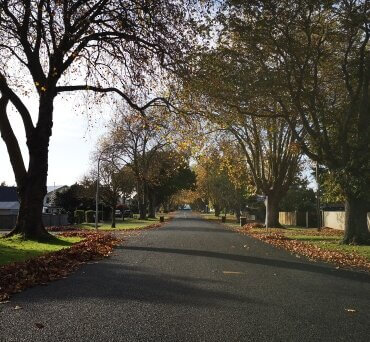

Road seal will now fill the whole of Hall Street. Photo: Mary Anne Gill.

Grahame Webber
The long wait for road and footpath improvements in one of Cambridge’s most historic streets is about to get a $350,000 refresh.
Surface water ponding, potholes, tree debris build up and broken sections of sealing on the footpaths have made the street “third world” for years, residents say.
Now, following their tenacity and advocacy from current and former deputy mayors Liz Stolwyk and Grahame Webber, the work should start in October.
And it can’t come soon enough, said residents’ spokesperson Alan Hayward who has submitted to two Long Term Plans spanning more than a decade to get the work done.

Liz Stolwyk
“It’s fantastic to hear they’ve all finally listened to the ratepayers,” he said.
“It’s only taken 110 years.”
Transportation manager Bryan Hudson told this week’s Service Delivery committee a draft and final design solution was completed in June.
Feedback from residents highlighted the need to seal the entire width of the road.
Hall Street is a designated heritage street which services hundreds of residents, raceway patrons and school students. It is one of the town’s oldest streets.

Alan Hayward
“The feedback highlighted council seals the entire width of the road, requests for maintenance of the Hall Street trees and general safety concerns for cyclists and motorists due to the broken pavement seal,” said Hudson.
A number of new stormwater soak holes and catch pits will be installed to collect stormwater and reduce berm flooding.
Pedestrian improvements will minimise crossing distances at Hall Street intersections with Clare, Williams, King and Taylor streets. A path at the Ngaio Crescent section will be taken to the road edge

Bryan Hudson
.
Where there are exposed metal areas, new road surfaces on the shoulders will be built.
Sections of broken footpath and kerb and channel will be replaced.
The new pavement surface will be an open graded porous asphalt to allow rainwater to support the heritage trees’ root sytems.
The street has a network of plane and maple trees.
“In areas where there are shallow tree roots, the pavement depth will need to be varied to not damage tree root systems, and the new surface will be hand laid to minimise damage to tree roots. During the construction works the nominated council arborist will be on-site to ensure care when working around the trees,” said Hudson.








